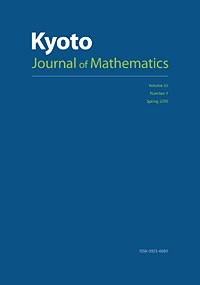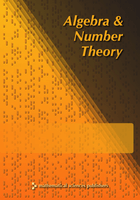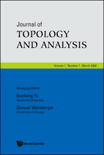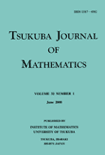
Selecta Mathematica-New Series
Scope & Guideline
Elevating Mathematical and Physical Sciences.
Introduction
Aims and Scopes
- Algebraic Geometry and Commutative Algebra:
The journal frequently publishes research related to algebraic geometry, focusing on topics such as schemes, varieties, and their properties. The interplay between algebra and geometry is a consistent theme, with numerous studies on moduli spaces, birational geometry, and related conjectures. - Representation Theory:
Representation theory is another core area, where the journal features papers discussing various representations of algebraic structures, including Lie algebras and quantum groups. This area often intersects with algebraic geometry and mathematical physics. - Homological Algebra and Category Theory:
Research on homological algebra, derived categories, and their applications is prevalent. This includes studies of functor categories, derived invariants, and categorical structures, reflecting a strong emphasis on abstract mathematical frameworks. - Topological and Geometric Methods:
The journal highlights research employing topological methods to address problems in various areas, including algebraic topology, symplectic geometry, and the study of manifolds. This includes the exploration of invariants and geometric structures. - Mathematical Physics:
There is a notable focus on mathematical physics, particularly in areas such as quantum field theory, algebraic topology, and integrable systems. Papers often explore connections between mathematical structures and physical theories, showcasing the journal's interdisciplinary approach. - Number Theory and Arithmetic Geometry:
The journal includes works that delve into number theory and its geometric aspects, often involving schemes, motives, and the interplay between arithmetic properties and geometric structures.
Trending and Emerging
- Derived Categories and Homotopical Algebra:
There is an increasing emphasis on derived categories and homotopical methods across various mathematical fields. This trend includes the exploration of new invariants and the relationships between different categorical frameworks. - Tropical Geometry and Its Applications:
Tropical geometry is gaining traction, with more papers exploring its applications in algebraic geometry and combinatorics. This emerging field is being integrated into classical theories, indicating a broader acceptance and interest in its methodologies. - Quantum Algebra and Categorification:
The trend towards quantum algebra and categorification is prominent, with research delving into quantum groups, categorified structures, and their applications in representation theory and geometry. This reflects a growing intersection between algebra and quantum physics. - Geometric Representation Theory:
Research in geometric representation theory is on the rise, particularly studies that link representation theory with algebraic geometry and topology. This emerging theme highlights the interdisciplinary nature of modern mathematics. - Mathematical Aspects of Machine Learning:
An increasing number of papers are addressing the mathematical foundations of machine learning, exploring topics such as optimization, statistical learning theory, and the geometry of data. This trend indicates a growing interest in applying advanced mathematical concepts to computational problems.
Declining or Waning
- Classical Algebraic Geometry:
Research specifically focused on classical aspects of algebraic geometry, such as the study of classical curves and surfaces, appears to be less frequent. The community has shifted towards more modern or abstract approaches, integrating concepts from algebraic topology and homological algebra. - Elementary Number Theory:
Papers centered exclusively on elementary number theory seem to be declining. The journal's focus has moved towards more complex interrelations between number theory and geometry, particularly in arithmetic geometry and its applications. - Real Analysis and Classical Analysis:
There is a noticeable reduction in submissions related to classical real analysis. The journal appears to be prioritizing more abstract and higher-dimensional analyses that connect to algebraic and geometric frameworks. - Combinatorial Geometry:
Research in combinatorial geometry has become less prevalent. The journal's recent publications indicate a trend towards more algebraically and topologically rigorous studies rather than combinatorial methods.
Similar Journals

Kyoto Journal of Mathematics
Unleashing potential through cutting-edge mathematical research.Kyoto Journal of Mathematics is a premier academic publication dedicated to advancing the field of mathematics, published by DUKE UNIVERSITY PRESS. Established in 1996, this journal serves as a vital platform for sharing innovative research and breakthrough studies across various mathematical disciplines. The journal has consistently maintained a prestigious Q1 ranking in the category of Mathematics (miscellaneous) as of 2023, reflecting its significant impact and contribution to the mathematical community. With its Open Access policy, the Kyoto Journal of Mathematics ensures that groundbreaking research is easily accessible to a global audience, fostering collaboration and knowledge dissemination among researchers, professionals, and students alike. The journal's commitment to excellence and relevance in mathematical research is underscored by its extensive archive of published works and its continuous engagement with contemporary mathematical challenges. This makes the journal an essential resource for anyone seeking to stay abreast of current trends and advancements in the field.

Algebra & Number Theory
Unveiling New Horizons in Mathematical ScienceAlgebra & Number Theory, published by Mathematical Science Publications, stands at the forefront of mathematical research, particularly in the fields of algebra and number theory. With an ISSN of 1937-0652 and E-ISSN 1944-7833, this esteemed journal provides a dedicated platform for the dissemination of cutting-edge theoretical advances and practical applications. It has achieved a Q1 category ranking in both algebra and number theory according to the 2023 quartiles, reinforcing its critical role in shaping contemporary mathematical discourse. The journal serves as an essential resource for researchers, professionals, and students alike, offering insights into diverse mathematical methodologies and fostering open dialogue among scholars. Although it does not provide open access, its robust impact factor reflects the high quality and relevance of its published work. Based in the United States at the University of California, Berkeley, the journal's commitment to excellence continues to attract contributions that push the boundaries of mathematical understanding.

New York Journal of Mathematics
Unlocking the potential of mathematical research for all.New York Journal of Mathematics is a prominent open-access journal, published by the ELECTRONIC JOURNALS PROJECT, dedicated to advancing the field of mathematics through the dissemination of groundbreaking research. Since its inception in 1996, the journal has evolved into a valuable resource for researchers, educators, and students, particularly in the realm of general mathematics. As of 2023, it proudly holds a Q2 classification in the Mathematics (miscellaneous) category, reflecting its growing impact and reach within the academic community, despite being ranked at the 31st percentile overall. With its commitment to open access since 2022, the journal ensures that high-quality mathematical research is readily available to a global audience, fostering collaboration and innovation. Researchers interested in contributing to this dynamic field will find the journal a vital platform for sharing their findings and engaging with fellow mathematicians around the world.

Forum of Mathematics Sigma
Advancing mathematical frontiers for a global audience.Forum of Mathematics Sigma is a premier open access journal published by Cambridge University Press that has been at the forefront of mathematical research since its inception in 2013. With a strong emphasis on advancing the fields of mathematics, the journal consistently achieves Q1 rankings across multiple categories, including Algebra and Number Theory, Analysis, and Computational Mathematics. This distinction highlights its impact and relevance within the scholarly community. The journal prides itself on providing a platform for innovative research, fostering collaboration among researchers and practitioners across various mathematical disciplines. Open access publication ensures that cutting-edge findings are widely available to readers globally, enhancing the dissemination of knowledge. With an address in the heart of Cambridge, England, Forum of Mathematics Sigma is dedicated to promoting high-quality research and making significant contributions to the development of mathematics.

CANADIAN JOURNAL OF MATHEMATICS-JOURNAL CANADIEN DE MATHEMATIQUES
Fostering collaboration and innovation in mathematics.Canadian Journal of Mathematics - Journal Canadien de Mathématiques is a prestigious peer-reviewed journal published by Cambridge University Press, which aims to advance the field of mathematics through the dissemination of high-quality research articles. With its ISSN 0008-414X and E-ISSN 1496-4279, the journal plays a pivotal role in fostering mathematical research and collaboration. It has been recognized for its impactful contributions, currently holding a category quartile ranking of Q2 in Mathematics (miscellaneous) for 2023 and sits in the 66th percentile among its peers according to Scopus rankings. As the journal continues its convergence from its inception in 1994 through to 2024, it remains a vital resource for researchers, professionals, and students seeking to stay at the forefront of mathematical developments. The journal does not operate under an open access model, allowing for a curated collection of articles that adhere to rigorous academic standards.

Documenta Mathematica
Unlocking the Potential of Mathematical DiscoveriesDocumenta Mathematica is a premier academic journal published by the European Mathematical Society (EMS), making significant contributions to the field of mathematics since its inception. With an Open Access model established in 1996, the journal ensures that scholarly works are freely available to a global audience, promoting widespread dissemination of mathematical research. Based in Germany, it serves as a vital platform for mathematicians, covering a wide array of topics within the discipline, evidenced by its impressive Q1 ranking in the miscellaneous category of mathematics as of 2023. Featuring rigorous peer-reviewed articles that span the latest trends and breakthroughs in the discipline, Documenta Mathematica also retains a commendable position among its peers with a Scopus rank of 163 out of 399, placing it in the 59th percentile for general mathematics. Researchers, professionals, and students alike will benefit from the robust scholarly content and the journal's commitment to advancing mathematical knowledge.

Journal of Topology and Analysis
Fostering Collaboration in Advanced Mathematical DisciplinesJournal of Topology and Analysis, published by WORLD SCIENTIFIC PUBL CO PTE LTD, is a distinguished peer-reviewed journal that focuses on advanced topics in mathematics, specifically within the fields of topology and analysis. Established in 2009 and running through 2024, the journal is based in Singapore and strives to present cutting-edge research that contributes to the mathematical community's understanding of geometric structures and analytical theories. Holding a respected position with a Q2 ranking in Analysis and a Q3 ranking in Geometry and Topology according to the 2023 category quartiles, the journal is indexed in Scopus, where it ranks #49 in Geometry and Topology and #118 in Analysis, showcasing its significance in the scholarly landscape. The Journal of Topology and Analysis aims to foster interdisciplinary collaboration by providing a platform for researchers, professionals, and students to share innovative findings and insights. Although it does not currently offer open access, its contributions are vital for advancing knowledge in these mathematical domains.

Tsukuba Journal of Mathematics
Advancing Mathematical Frontiers with Rigorous ResearchTsukuba Journal of Mathematics is a distinguished publication dedicated to advancing the field of mathematics through the dissemination of innovative research and comprehensive studies. Published by the University of Tsukuba, Department of Mathematics, this journal serves as a vital platform for mathematicians, researchers, and students to engage with cutting-edge mathematical theories and methodologies. Although currently not available as an open-access journal, it maintains a strong academic presence, contributing significantly to the global mathematical landscape. The journal invites submissions across various branches of mathematics, aiming to foster scholarly communication and collaboration. The ISSN 0387-4982 and the E-ISSN 2423-821X further establish its credibility and accessibility among the academic community, supporting its critical objective of facilitating high-quality research output. Situated in Tsukuba, Japan, a hub for scientific research and development, the Tsukuba Journal of Mathematics is committed to bridging gaps in mathematical knowledge and encouraging exploration of novel ideas.

ANNALES DE L INSTITUT FOURIER
Elevating Mathematical Discourse GloballyANNALES DE L INSTITUT FOURIER is a premier academic journal published by ANNALES INST FOURIER, specializing in the fields of Algebra and Number Theory as well as Geometry and Topology. Since its establishment, the journal has garnered a distinguished reputation, evidenced by its Q1 quartile ranking in the 2023 category assessments and its Scopus Rank of #37 out of 119 in Algebra and Number Theory, and #34 out of 106 in Geometry and Topology, placing it within the top percentile of its field. The journal serves as a vital platform for disseminating groundbreaking research and innovative methodologies, catering to a global audience of researchers, professionals, and students. With a commitment to the advancement of mathematical sciences, ANNALES DE L INSTITUT FOURIER invites contributions that push the boundaries of knowledge and foster collaboration across disciplines. Although it does not offer open access, the rigorous peer-review process ensures that published papers meet the highest academic standards, making it a critical resource for anyone engaged in advanced mathematical research.

JOURNAL OF THE AMERICAN MATHEMATICAL SOCIETY
Transforming Ideas into Mathematical BreakthroughsThe Journal of the American Mathematical Society (ISSN: 0894-0347; E-ISSN: 1088-6834), published by the American Mathematical Society, stands as a pillar in the fields of mathematics and applied mathematics. This prestigious journal, with a remarkable impact factor and ranking in the top tier (*Q1*) within both the Applied Mathematics and general Mathematics categories, is recognized for its contribution to advancing mathematical research and theory. With data reflecting it as the 8th ranked journal in General Mathematics (top 2%) and the 34th in Applied Mathematics (top 6%), the journal consistently showcases groundbreaking studies and innovative methods that greatly influence academia and industry alike. Though not an open-access journal, it offers a wealth of resources and intellectual discourse for researchers, professionals, and students alike. Specializing in comprehensive and theoretical aspects of mathematics, the Journal remains dedicated to publishing articles that promote understanding and propel the field forward, highlighting its significance as an essential tool for those engaged in mathematical research.